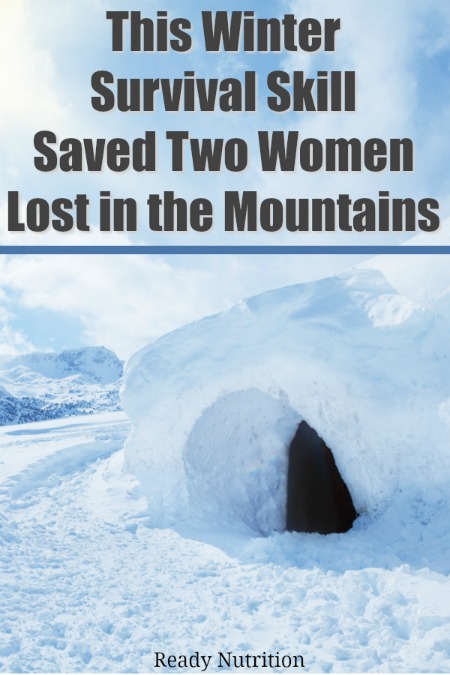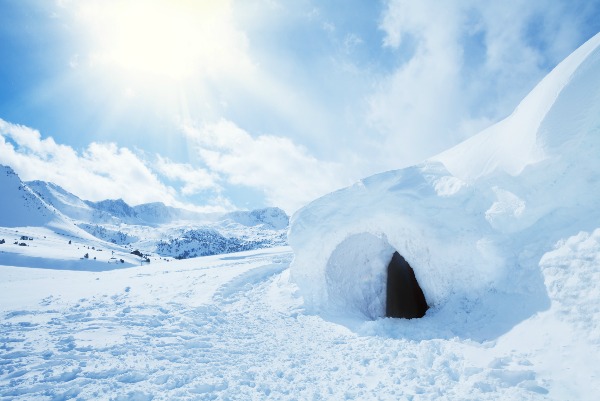Emergencies happen when we least expect them, and as two women recently found out, when you plan for the worst, your odds of survival increase.
A survival story made headlines recently about two women who lost their way in the Sierra Nevada mountains over President’s Day Weekend. The two became disoriented in the snow and lost their way while cross-country skiing and spent two days in harsh winter elements before they were able to notify relatives that they were lost, and the relatives then called 911. Emergency responders are now claiming they survived subzero temperatures from knowing how to make a winter survival shelter.

Image Source: Mountain Democrat
In the article:
El Dorado County Sheriff’s Deputy Greg Almos said they received the call about the women’s distress at midnight on Saturday. On Sunday they did a “hasty search” but all attempts were failing due to conditions, Almos said that even snowmobiles and a snow cat couldn’t navigate in the deep snow. “We even contemplated sending a drone,” he said, but there was a blizzard. “It’s tough to even send people out there due to the conditions.”
Fortunately, the women knew enough to build a snow cave in the heavy snow and were able to survive Saturday night when temperatures dropped below freezing.
….
Jared Boothe, a flight officer/paramedic with the California Highway Patrol’s Valley Division Air Operations said the helicopter crew spotted the women around 9:30 a.m. on Monday. “If they hadn’t had the skill set and experience to build a snow cave, it likely would have been a fatal event as temperatures were reported to be a minus 8 degrees without considering wind chill,” Boothe said. “If they had sat out in the open, they likely wouldn’t have made it out.”
Navigating in the Snow
It is easy to become disoriented in a snowy landscape. In a previous article about navigating the snow, the writer states it’s more difficult than one would think. “First, with snow blanketing the landscape, the appearance of the terrain is changed. Secondly, the landscape is also physically altered: it is a different thing to walk across six inches to several feet of snow. Right now, where I live, I have almost three feet of snow on the ground. The winter weather conditions are another item: it’s a far cry from a summer stroll when you walk into a cold wind that is throwing sleet right into your face in the middle of February.” He emphasizes knowing the terrain and pace count is the best way to navigate in a wintry area.
While it should go without saying, dress appropriately for winter conditions. You never know when you will find yourself staring down the business end of an emergency situation. “Pick up a good pair of goggles that do not fog up, and appropriate shielding for the face. Make sure you’re dressed in all-weather to combat the weather. I recommend Gore-Tex from head to toe. A GPS compass will help, but here it is important to rely on the basics because batteries do die, electronics can be fouled up by extremes in weather and temperature, and it’s always best to rely on the “primitive” and skills.” Try this compass instead.
Other lightweight tools to keep in mind are:
- Ax
- Survival knife with 4-6 inch blade
- Extra long Mylar blanket
- Waterproof winter gloves
- Shovel
- Paracord
How a Snow Cave Will Protect You
If you find yourself in a situation like the women skiers who lost their way, learn from their survival story and teach yourself essential winter skills. A snow cave or a quinzee will protect you from the elements and is perfect for areas where snow is not too deep and has powdery snow in order to form correctly. This snow shelter uses the powdery snow which will pack and bond together so that it is easier to hollow out and form a shelter. A properly made snow cave can be 0 °C (32 °F) or warmer inside, even when outside temperatures are −40 °C (−40 °F).
A snow cave is constructed by excavating snow so that the tunnel entrance is below the main space to retain warm air. If made correctly, your body heat will insulate and heat the inside of the cave and save your life.
The video provides step-by-step instructions. If you do not have a shovel on hand, look for makeshift tools like a flat rock or a split piece of wood.
Keep These Winter Shelter Tips in Mind
- If you can face your shelter towards the east you will be able to prevent heat loss from prevailing winds and storms coming into your shelter.
- Protect yourself from the elements by using branches, sticks, tarps or whatever you have available. Pine branches are great for wind-proofing your shelter and preventing heat loss from the ground.
- Body heat can quickly escape if you do not have a ground insulator. If you can make your bedding area off the ground, you will be able to conserve more body heat. Consider pine needles, leaves, spruce boughs and/or branches, or even building up the snow around your primitive shelter.
- Dehydration in cold climates can be a major risk when outdoors. Excessive perspiration, heavy clothing, and increased respiratory fluid loss are other factors that contribute to dehydration in cold climates. For example, when you can see your own breath, that’s actually water vapor that your body is losing. The colder the temperature and the more intense the exercise, the more vapor you lose when you breathe.
- Take into consideration your energy output on building the shelter versus the protection of the shelter. This is labor intensive so be mindful of how much time it is taking to ensure you are not overexposed to the winter elements. Being exposed to the elements longer than three hours could be life-threatening.
Start training for winter survival emergencies with some basic shelters and then move into more advanced. Knowing these skills could save your life!
Additional Reading:
A Step-By-Step Guide To Prepare You For Any Disaster
A Green Beret’s Guide To Building an Emergency Winter Shelter

This article was originally published at Ready Nutrition™ on February 25th, 2019








It’s a good skill however common sense is a better one. Don’t go in unprepared, without supplies, let others know where you are going and when you should be back.
Umm how freakin about don’t go hiking in freakin winter?? Accident? Sure, but voluntarily go out there? Not so much
I have never really had a great passion for skiing, or being out in snow, let alone even think about CAMPING out in it !!! Leave the snow alone, and, just be content watching it from inside your house, if you live in snow country, or, on TV, if you don’t !!!
This is an excellent article. Anytime you are going to be out in a wooded area, even it it’s close to your house, you should have a small survival pack with you that includes, matches or lighters or other fire starters, emergency blankets and/or tents, a knife, and some type of energy or food bars. Having a cup that can be put over the fire to heat water or snow for water would be a bonus. There are other small items you can add to your survival pack, but try to keep it light and purposeful. Check online for things that can save your life and pack those.